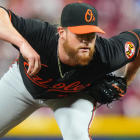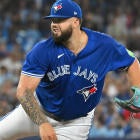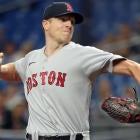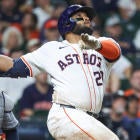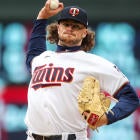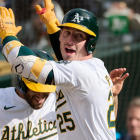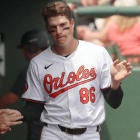Note: Don't whiff on this special FanDuel offer. Win your first contest or get your money back (up to $10) to keep playing. Try FanDuel now!
I owe Tanner Roark a thank you. Not only did his 15-strikeout performance against the Twins last weekend help me out in one of my leagues, but it led me to an astonishing discovery.
In piecing together how Roark put together a masterful start seemingly out of nowhere, I noticed that he got called strikes on 32 out of 121 pitches. Freezing batters on 26 percent of your pitches is pretty notable, given that the major league rate is typically just over 17 percent. Over his first three starts of the season, Roark posted a near-normal 18 percent rate, but his Twins start may not be the outlier it appears to be. He faced the Marlins twice and the Braves once in his prior outings, and both of these teams have been eager to swing the bats. Getting an above-average called strike rate against them is not an easy feat.
My discovery is not about Roark, though there will be more about him later. In scanning the called strike rate leaderboard, I did find Roark, who ranks 12th at 20.8 percent. I also found Aaron Nola sitting at the top with a 28.1 percent called strike rate. The next closest pitcher on the list, Jhoulys Chacin, was nearly six full percentage points behind at 22.2 percent.
Even though Nola is lapping the field in this particular stat, he has thrown just 375 pitches this season. Going back to the larger sample from last season's rookie campaign, Nola was still quite adept at getting called strikes, posting a 21.2 percent rate. Given that Nola has clearly been good at this and is seemingly getting better, I wanted to see what type of pitcher he could be if he simply regressed to the point of being one of the best pitchers at getting called strikes, as opposed to dominating the leaderboard.
In comparing Nola to other pitchers, let's use all 17 of his career starts, putting him closer to a full season's worth of stats. Over those starts he has thrown 1,492 pitches, so I compiled a list of every pitcher since 2013 who has thrown at least 1,400 pitches in a season. Only Bronson Arroyo had a season that eclipsed Nola's career 22.9 percent called strikes rate; in 2013, he got called strikes on 23.2 percent of his pitches. However, Arroyo was like many of the pitchers who ranked high in this list in that he didn't get many whiffs. Of the 15 pitcher seasons that resulted in a called strike rate of 21.0 percent or higher, seven of them (including Arroyo's) featured a swinging strike rate below 7.5 percent. All but three of them coincided with whiff rates below Nola's career average of 10.1 percent.
In his young career, Nola has shown the ability to be above-average as both a bat-misser and a bat-freezer, and that has been a rare combination. The three pitchers who also showed those traits are David Price, Chris Sale and Cliff Lee. That's obviously great company to have, and in terms of the ability to generate swinging strikes and strikeouts, his closest comp appears to be Lee, circa 2013.
| Pitcher | Year(s) | Called Strike Rate | Whiff Rate | K% |
| David Price | 2014 | 21.1% | 12.1% | 26.9% |
| Chris Sale | 2013 | 21.6% | 11.8% | 26.1% |
| Cliff Lee | 2013 | 21.4% | 10.2% | 25.3% |
| Aaron Nola | 2015-16 | 22.9% | 10.1% | 23.3% |
Nola shares Lee's pinpoint control, and he has been even better than Lee at avoiding contact on pitches he throws in the strike zone. However, Nola isn't necessarily destined to fill Lee's shoes in the Phillies' rotation. His profile is also not that different from that of the 2014 version of Jesse Chavez, who posted a 21.2 percent called strike rate and a 9.6 percent whiff rate. That season, Chavez finished with a 3.45 ERA and an 8.4 K/9 ratio (and a 21.9 K%). If not for an extremely high foul ball rate, Lee may not have had as many strikeouts, and his stat line could have looked more like Chavez's.
Nola has not gotten many strikes via foul balls, but his control has been much closer to that of Lee than Chavez. Also, even a regressed version of Nola will be a better inducer of called strikes than Lee, and his whiff rate is trending upwards. While we shouldn't go overboard on the basis of his four 2016 starts, it's not hard to imagine Nola staying on a trajectory to get a strikeout per inning with an extraordinary WHIP. He should also be able to whittle his ERA down to around 3.00, despite allowing more than the occasional home run. That sounds an awful lot like Lee.
So what about Roark? As mentioned above, he has also been very good at getting called strikes, even though he has faced some trigger-happy lineups. Owen Watson did a nice job of looking behind Roark's improvement in a piece on FanGraphs, emphasizing that he has been getting increased horizontal movement on his sinker. Roark's sinker has been a difference-maker so far this season, as he has induced swings on 38.9 percent of those offerings so far in 2016, as compared to 44.4 percent previously (according to BrooksBaseball.net). It's also worth noting that Roark has raised the release point on his sinker and has increased the vertical movement on it.
Even with the mechanical changes and increased movement, Roark won't be in Nola's class. He has struggled with control and efficiency, and has been getting whiffs at an 8.8 percent rate. Still, if the changes stick, they will lift Roark up from being a fringy SPARP option in Head-to-Head leagues to being a mainstay in those formats and a viable streamer in standard mixed Roto leagues.
It's hard to know what this year's high called strike rates will mean for Nola and Roark over the long term, as some pitchers like Sale aren't able to sustain high rates year after year. Others, though, like Lee, Price, Andrew Cashner and Doug Fister, have a knack for freezing batters on a consistent basis. Given how superb Nola's command has been so far, I would expect him to carry this skill over the course of many years.


















